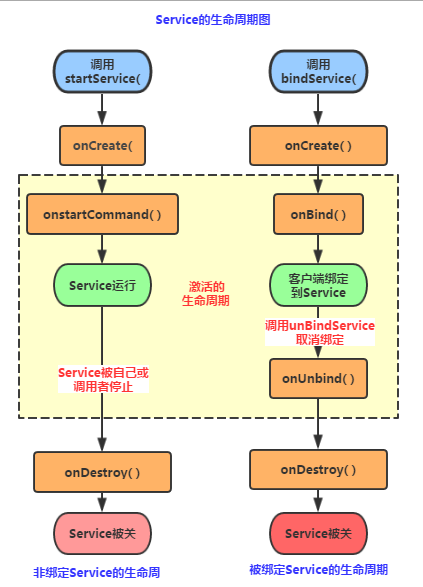Service
Service是一个可以在后台执行长时间运行操作而不提供用户界面的应用组件。
服务是Android中实现程序后台运行的解决方案。
主要用于在后台处理一些耗时的逻辑,或者某些需要长期运行的任务,比如下载。
服务依赖于创建服务时所在的应用程序进程,当应用程序进程被关掉后,所有依赖于该进程的服务也会停止运行。
服务中的代码也是运行在主线程中的。
1.创建一个服务
要创建一个服务,必须创建Service 的子类(或使用它的一个现有子类)。
通过Android Studio来创建服务
右键包名然后 New>Service>Service
创建时有两个属性可以勾选,
Exported属性表示其他程序访问这个服务,Enabled属性用于表示是否启用这个服务。
注意:每个服务都需要在AndroidManifest.xml中进行注册才能生效。Android Studio 已经帮我们创建好了。
<application
<service
android:name=".MyService"
android:enabled="true"
android:exported="true">
</service>
</application>这个是创建好的类: 关于onBind()方法,之后再活动和服务之间的通信会用到
public class MyService extends Service {
public MyService() {
}
@Override
public IBinder onBind(Intent intent) {
// TODO: Return the communication channel to the service.
throw new UnsupportedOperationException("Not yet implemented");
}Service 中常用的几个方法:
- onCreate() :服务创建时调用
- onStartCommand() :服务每次启动时调用
- onDestroy() :服务销毁时调用 ,一般用于回收资源
2.开启和关闭服务
- 开启服务:
Intent startIntent=new Intent(MainActivity.this,MyService.class);
startService(startIntent);首次启启动时会创建一个Service实例,并一次调用onCreate()和onStartCommand()方法进入运行状态,如果再次调用StartService()启动Service,将不会再创建新的Service对象,而是会重用前面创建的Service对象,并调用onStartCommand()方法。
- 关闭服务:
Intent stoptIntent=new Intent(MainActivity.this,MyService.class);
stopService(stoptIntent);另外也可以通过在服务中调用 stopSelf() 来关闭服务
3.Service和Activity之间的通信
我们需要通过Service中的 onBind()方法来实现通信。
比如说我们要实现下载功能,我们需要创建一个内部Binder类,并通过内部类对象来对下载进行管理
public class MyService extends Service {
private DownLoadBinder mBinder=new DownLoadBinder();
@Override
public IBinder onBind(Intent intent) {
return mBinder;
}
class DownLoadBinder extends Binder{
public int progress=0;
public void startDownLoad(){
new Thread(new Runnable() { //在子线程中执行
@Override
public void run() {
Log.d("MyService", "startDownload executed");
while (progress <= 100) {
try { //模拟耗时操作
Thread.sleep(1000);
} catch (InterruptedException e) {
e.printStackTrace();
}
progress++;
}
}
}).start();
}
public int getProgress(){
return progress;
}
}
}然后在MainActivity中需要修改的是:
创建ServiceConnection匿名类和自定义的Binder类,并通过向下转型得到DownLoadBinder的实例
private MyService.DownLoadBinder downLoadBinder;
//监听活动和服务的连接状况,如果成功则回调onServiceConnected()
private ServiceConnection connection=new ServiceConnection() {
@Override
public void onServiceConnected(ComponentName name, IBinder service) {
Log.d(TAG, "onServiceConnected: ");
downLoadBinder=(MyService.DownLoadBinder)service;
downLoadBinder.startDownLoad();//开始下载
}
@Override
public void onServiceDisconnected(ComponentName name) {
Log.d(TAG, "onServiceDisconnected: ");
}
};- 绑定服务:
Intent bindIntent=new Intent(MainActivity.this,MyService.class);
bindService(bindIntent,connection,BIND_AUTO_CREATE);但三个参数BIND_AUTO_CREATE,表示在活动和服务进行绑定之后自动创建服务,
这样会使服务中的onCreate()执行,但是startCommand()不会执行,
- 解绑服务:
unbindService(connection);当解除绑定后服务也就紧跟着销毁了
接下来我们就可以调用 downLoadBinder 的相关方法进行操作,实现在活动中调用服务中方法
比如 获取当前下载进度:
downLoadBinder.getProgress()注:服务可以跟整个应用程序中任意一个Activity进行绑定,并获取Binder实例。
4.服务的生命周期

注:图片来自 菜鸟教程 http://www.runoob.com/w3cnote/android-tutorial-service-1.html
当我们对一个服务即调用了startService()方法,又调用了bindService()方法
Android 系统的机制是,一个服务只要被启动或者被绑定后,就会一直处于运行状态,必须要两种状态同时不满足,服务才会销毁。
所以我们需要通过同时调用stopService()和unbindService()方法来销毁这个服务。
5.前台服务
服务的系统优先级相对来说还是比较低的,所有当系统出现内存不足的情况下,就有可能会回收掉正在后台运行的服务。当我们需要服务一直保持运行状态时,就可以考虑使用前台服务。
前台服务和普通服务的最大区别就是,前台服务会在状态栏一直显示一个通知。常见的有(网易云音乐、360...)
@Override
public void onCreate() {
//前台服务
Intent intent=new Intent(this,MainActivity.class);
PendingIntent pi=PendingIntent.getActivities(this,0,new Intent[]{ intent},0);
notificationBuilder= new NotificationCompat.Builder(this);
notificationBuilder.setContentTitle("Download") ; //标题
notificationBuilder.setWhen(System.currentTimeMillis()); //通知被创建的时间
notificationBuilder.setSmallIcon(R.mipmap.ic_launcher); //状态栏通知图标
notificationBuilder.setProgress(100,1,false); //条形进度条显示
notificationBuilder.setAutoCancel(true);
notificationBuilder.setContentIntent(pi); //点击通知事件
//发送通知,并将服务变为前台服务
startForeground(1,notificationBuilder.build());
}接着我们可以调用setProgress()方法来更新进度条
notificationBuilder.setProgress(100,progress,false);
notificationBuilder.setContentText(progress+"/100");重点就是startForeground() ,这个方法会将服务变为前台服务,并在系统状态栏中显示出来。
6.IntentService
IntentService可以简单地创建一个异步的、会自动停止的服务。
创建MyIntentService
public class MyIntentService extends IntentService {
private static final String TAG = "MyIntentService";
public MyIntentService(){
super(""); //必须调用父类的有参构造函数,否则会抛异常
}
@Override
protected void onHandleIntent(Intent intent) {
Log.d(TAG, "onHandleIntent: ");
Log.d(TAG,"Thread name :"+ Thread.currentThread().getName());
}
@Override
public void onDestroy() {
Log.d(TAG, "onDestroy: ");
super.onDestroy();
}
}最后不要忘了在AndroidManifest.xml中进行注册服务
<service android:name=".MyIntentService"/>启动服务:
Intent intentService=new Intent(this,MyIntentService.class);
startService(intentService);注意:
IntentService 运行完毕后是自动停止。
MyIntentService 中必须调用父类的有参构造函数,否则会抛异常
One comment